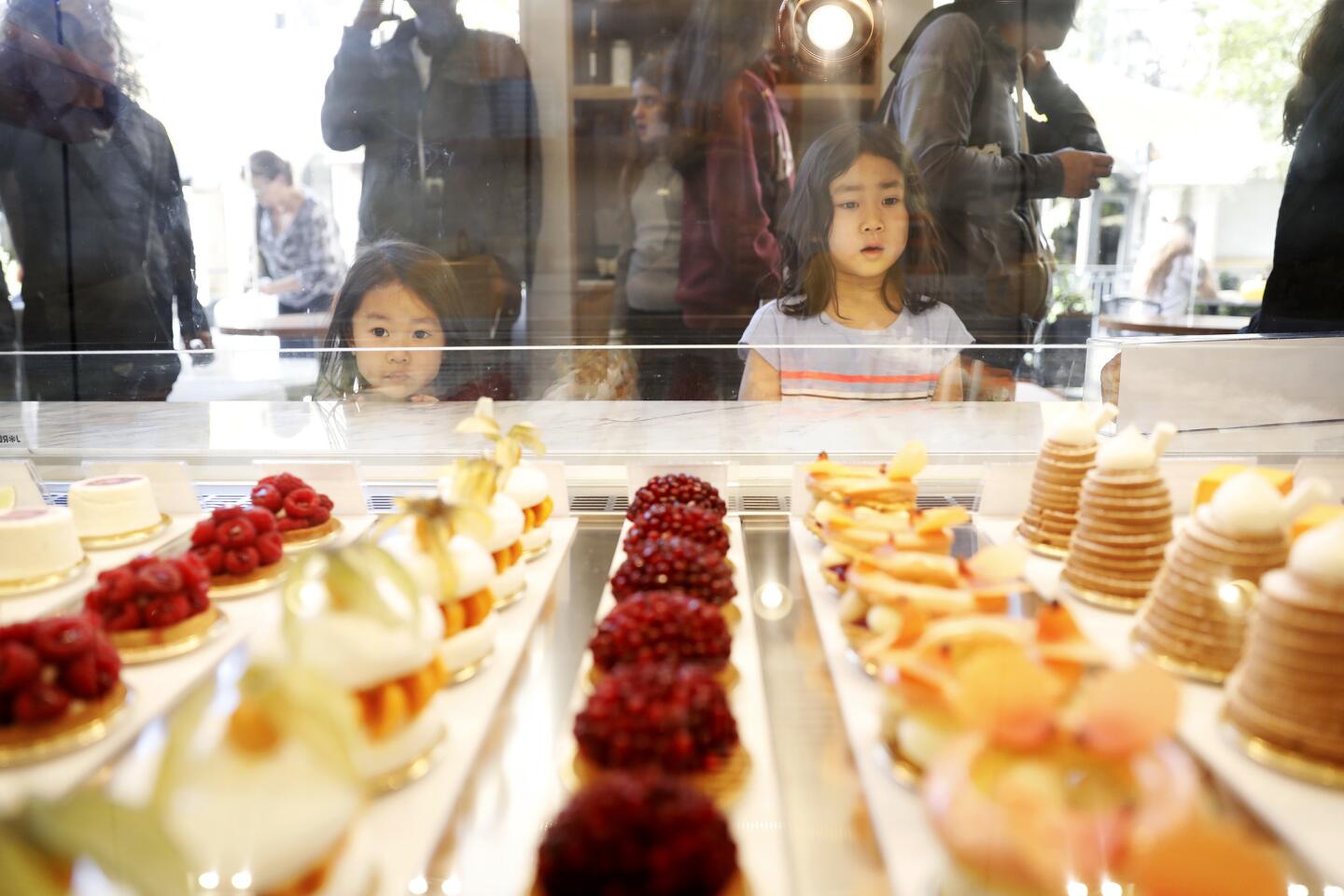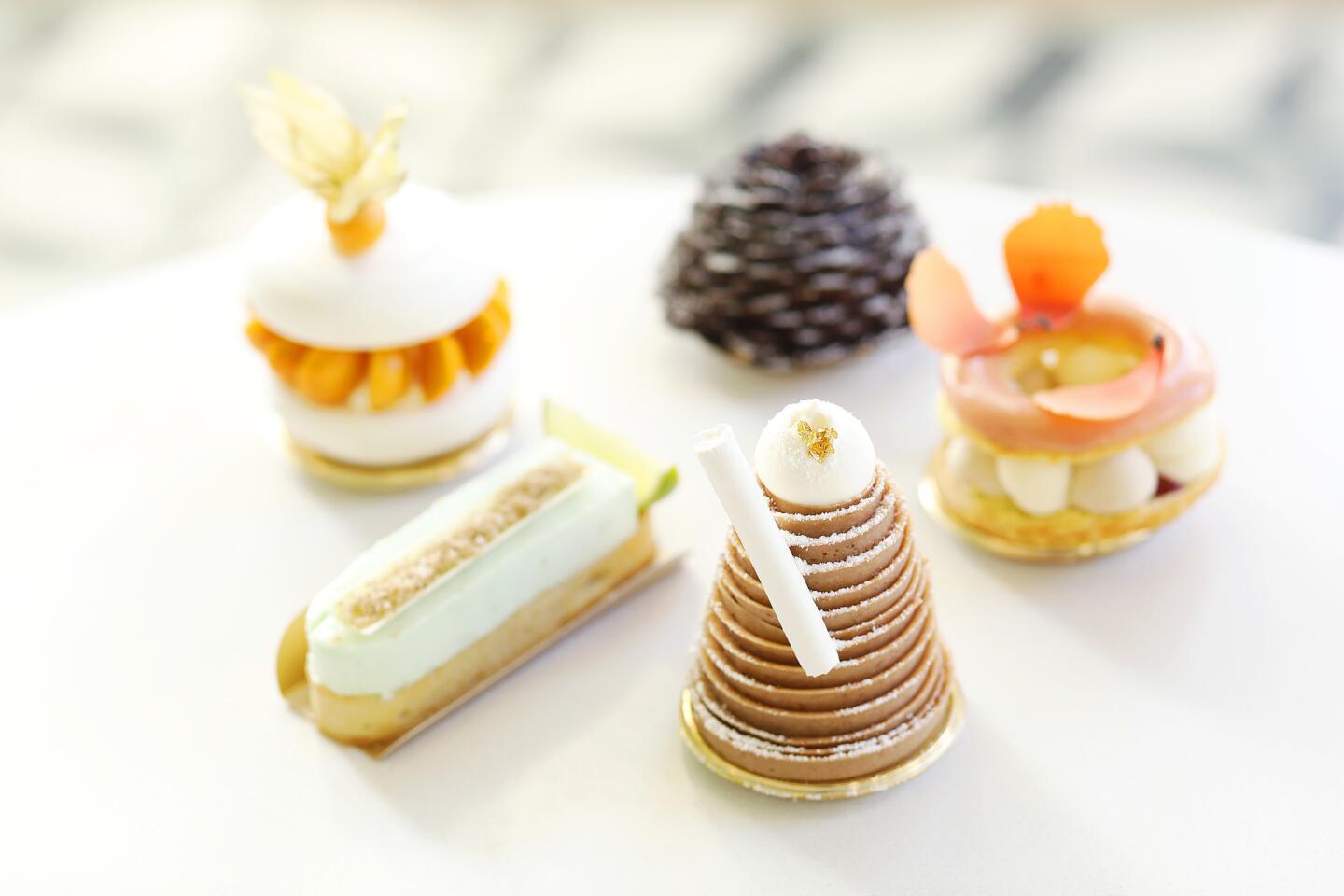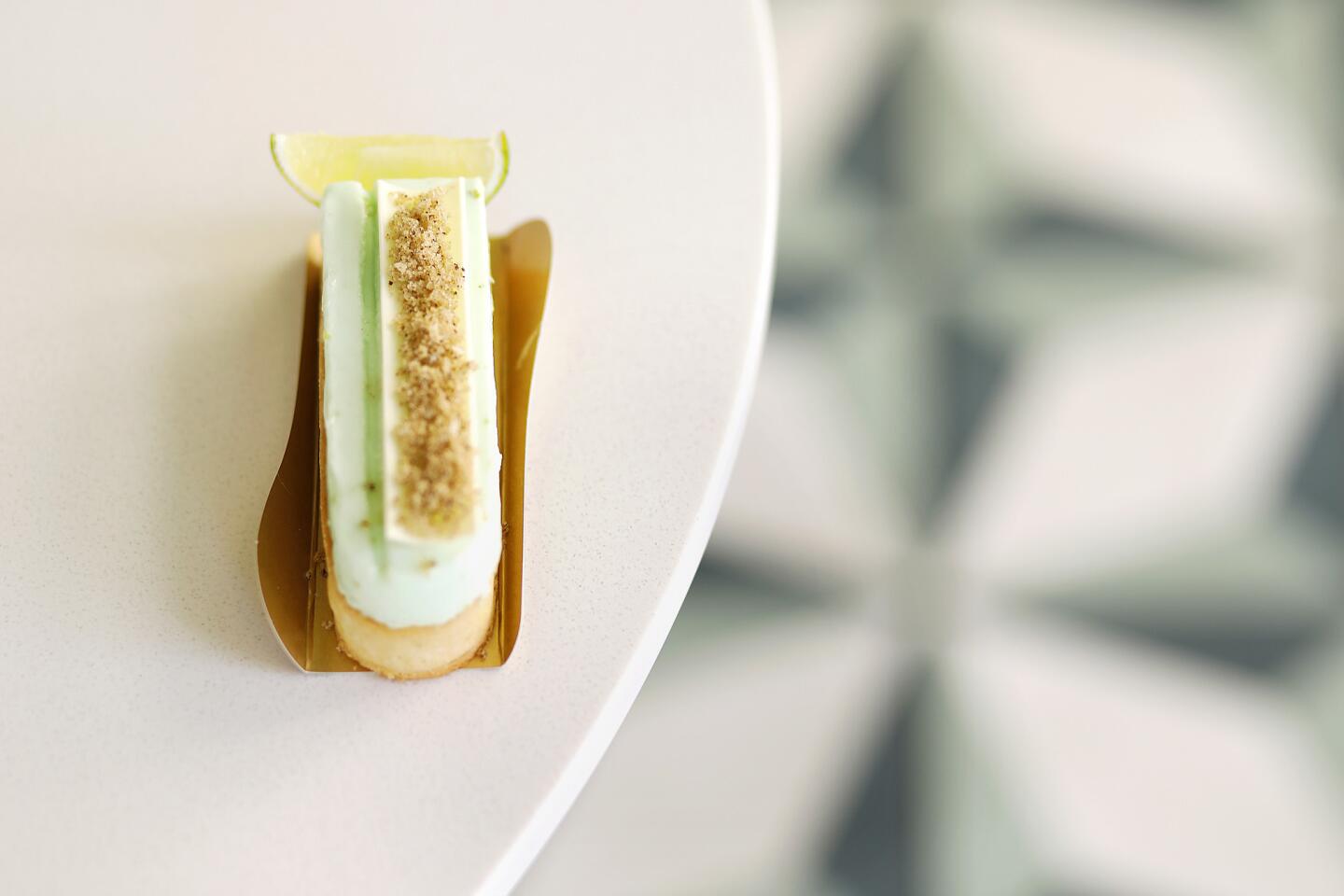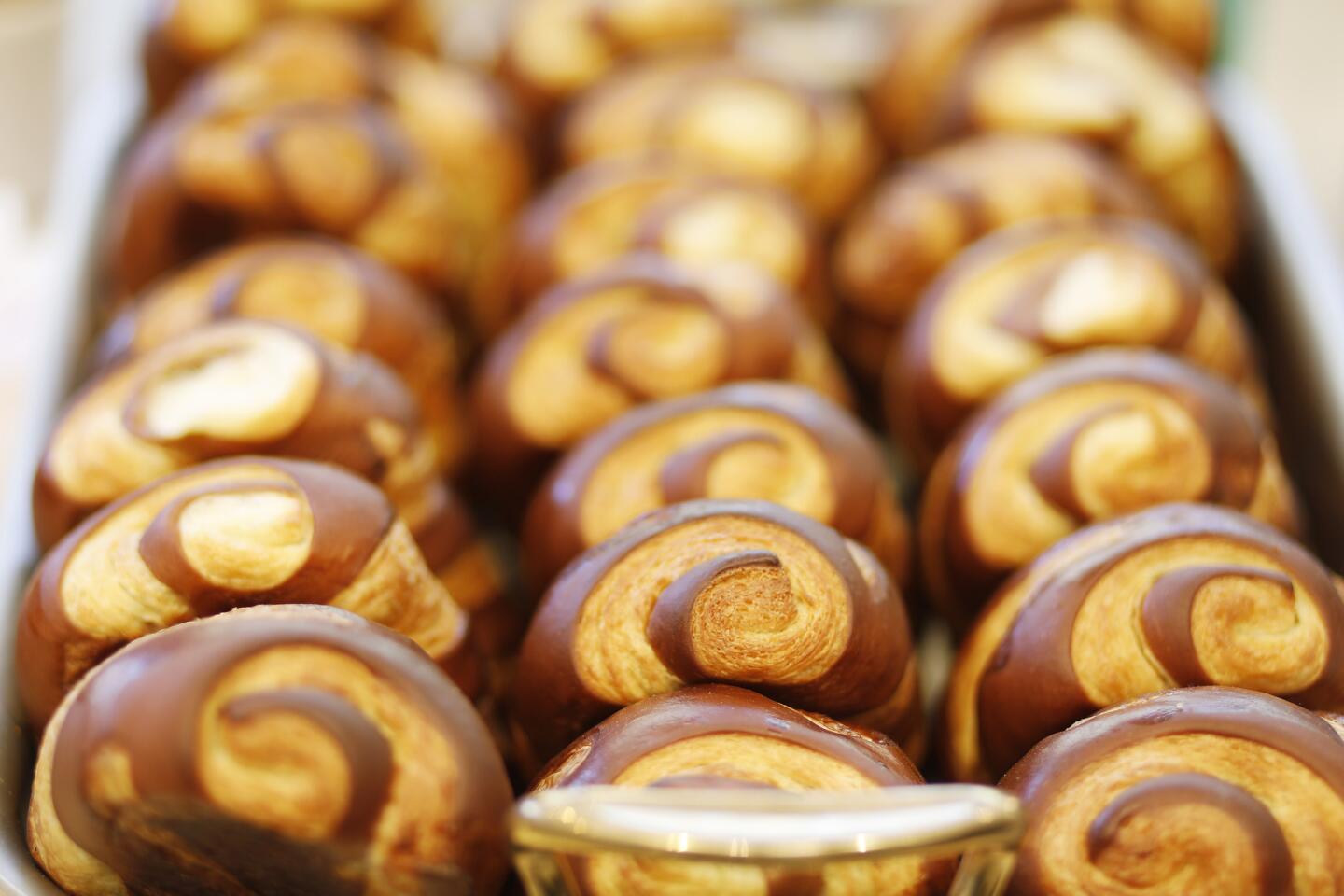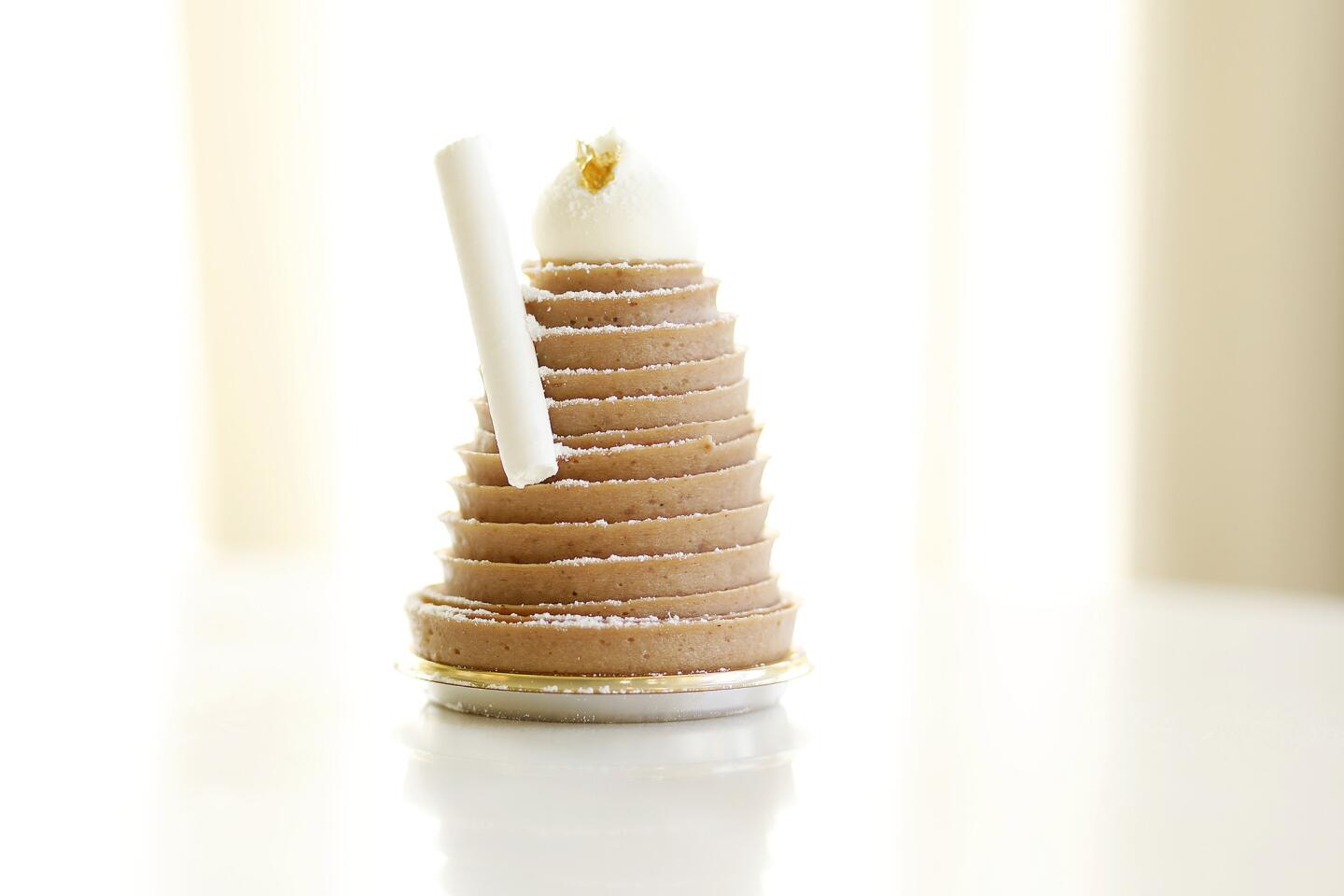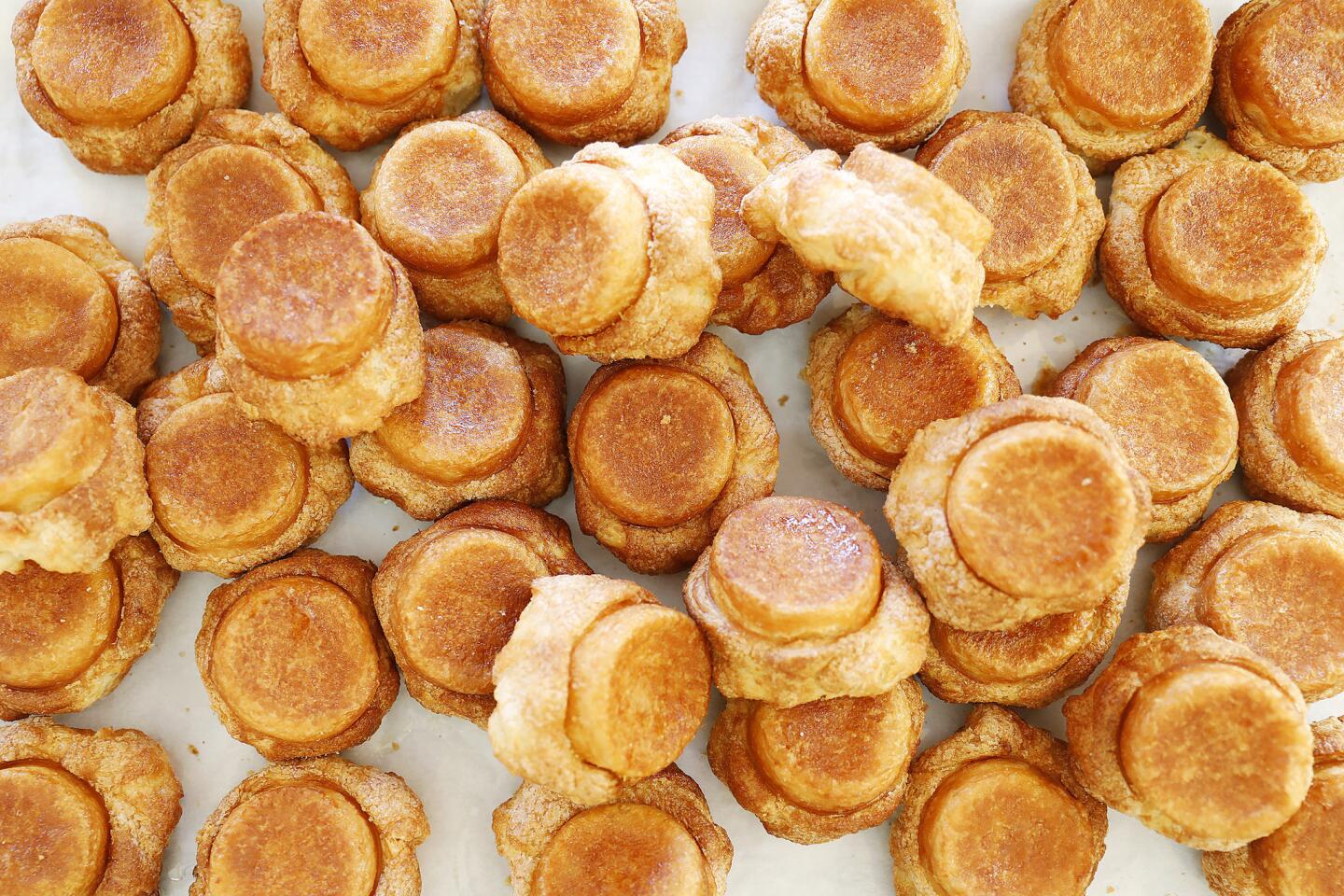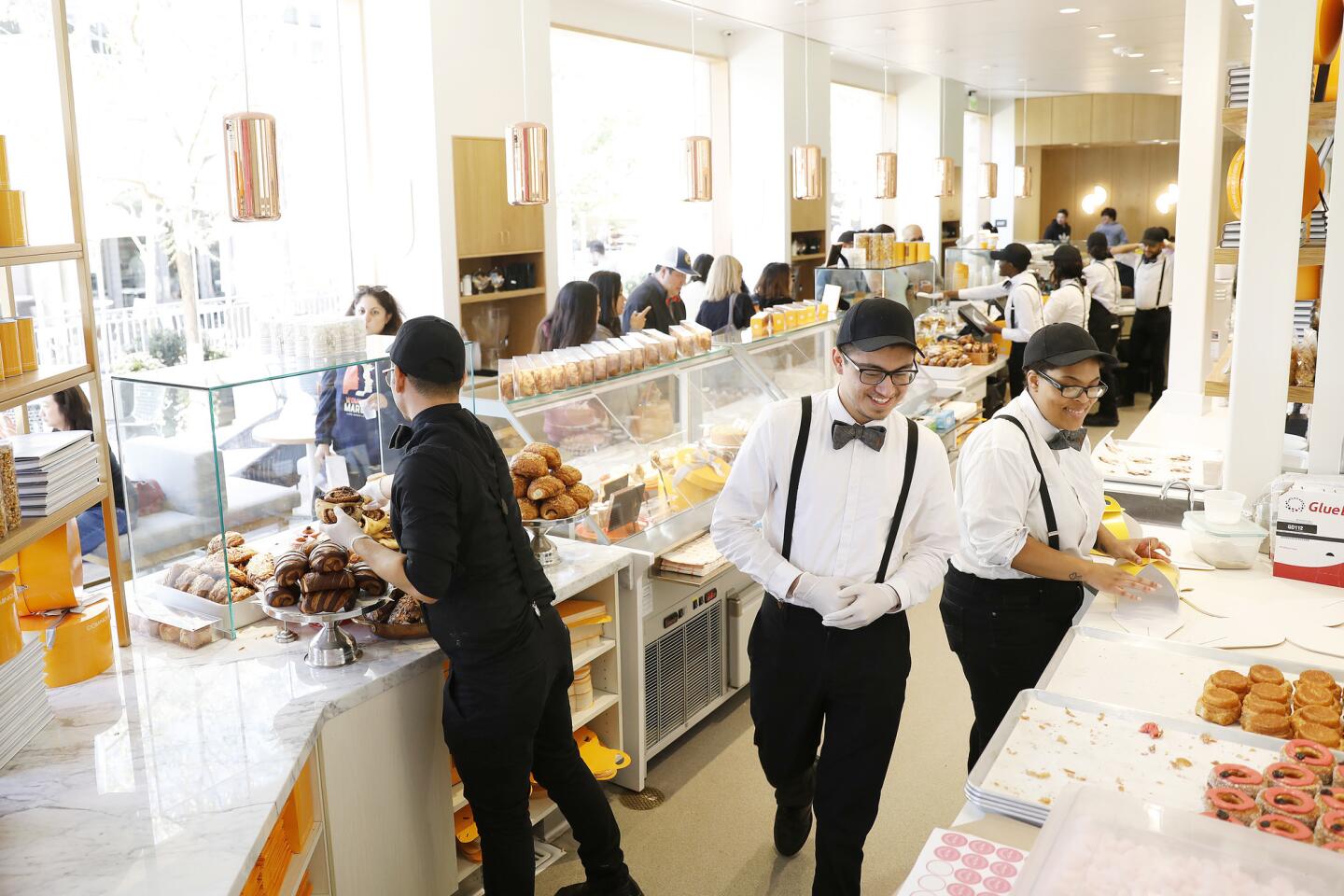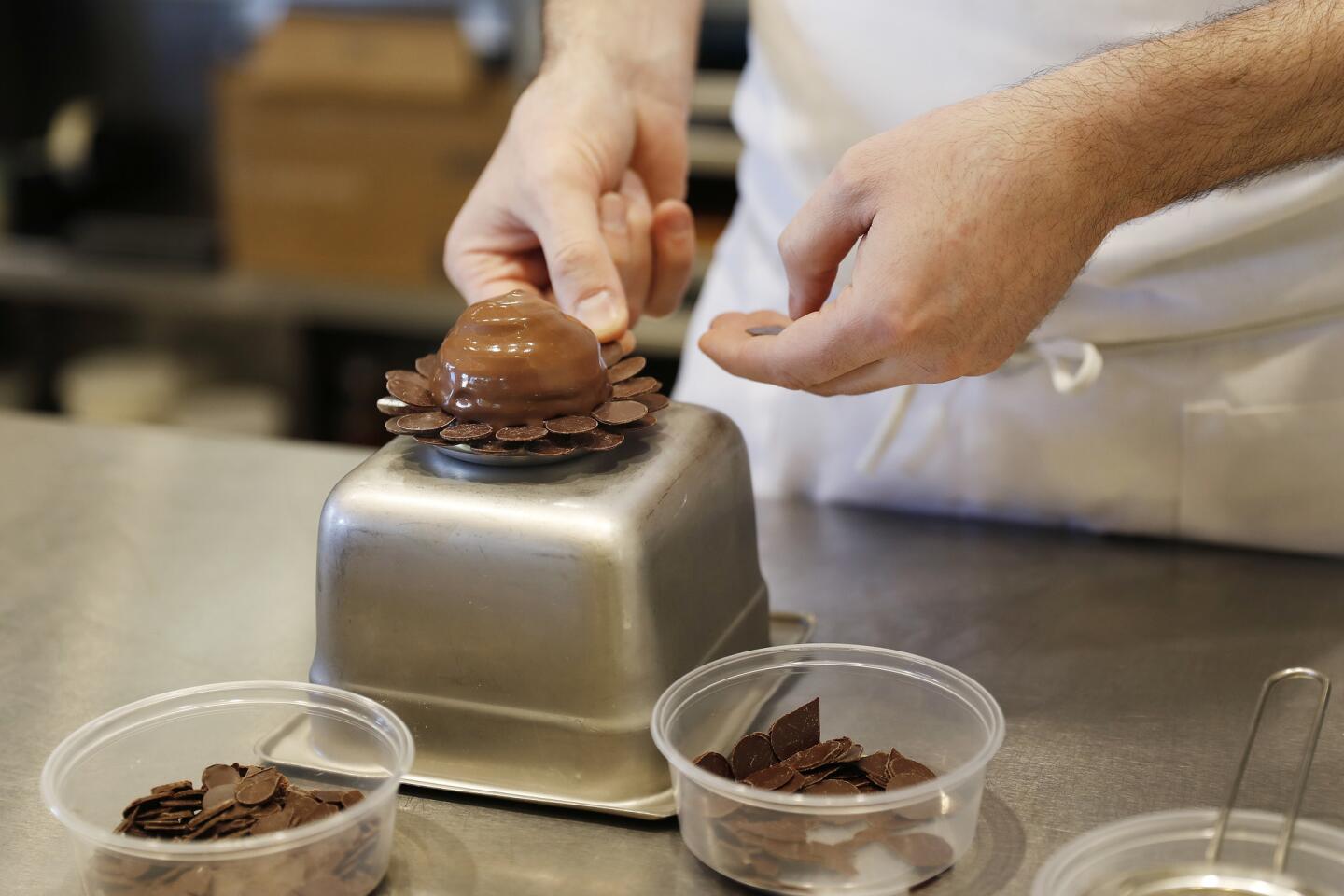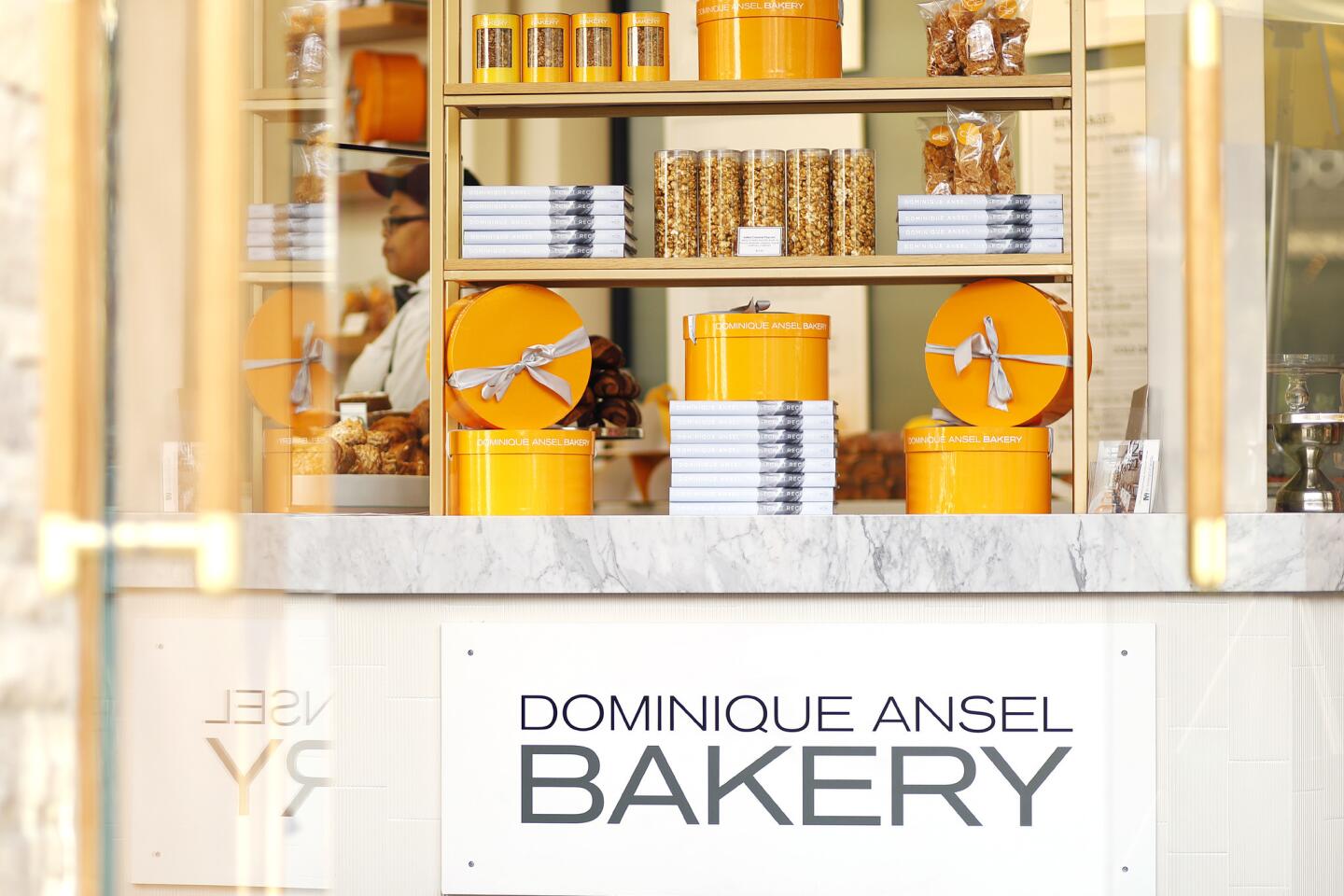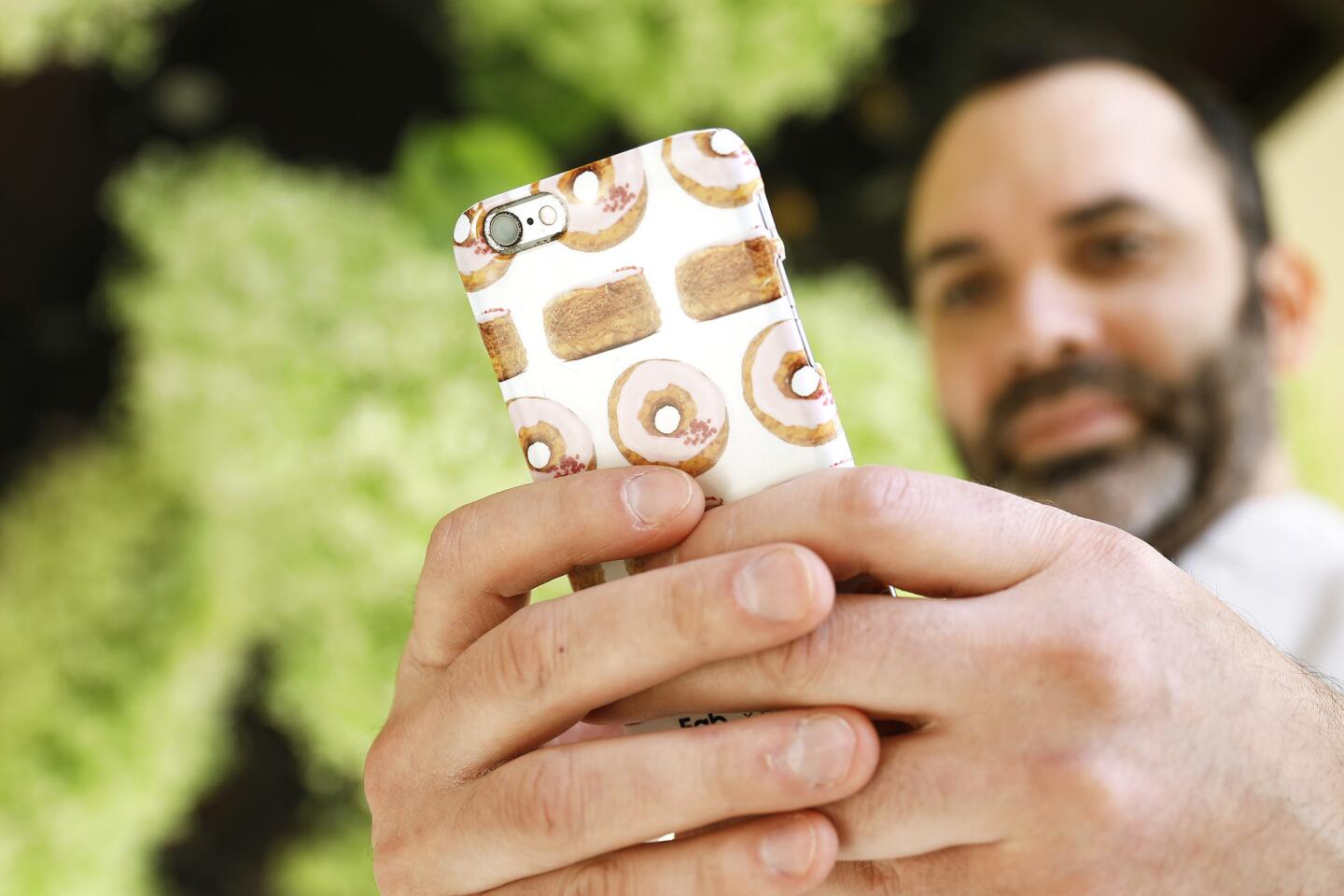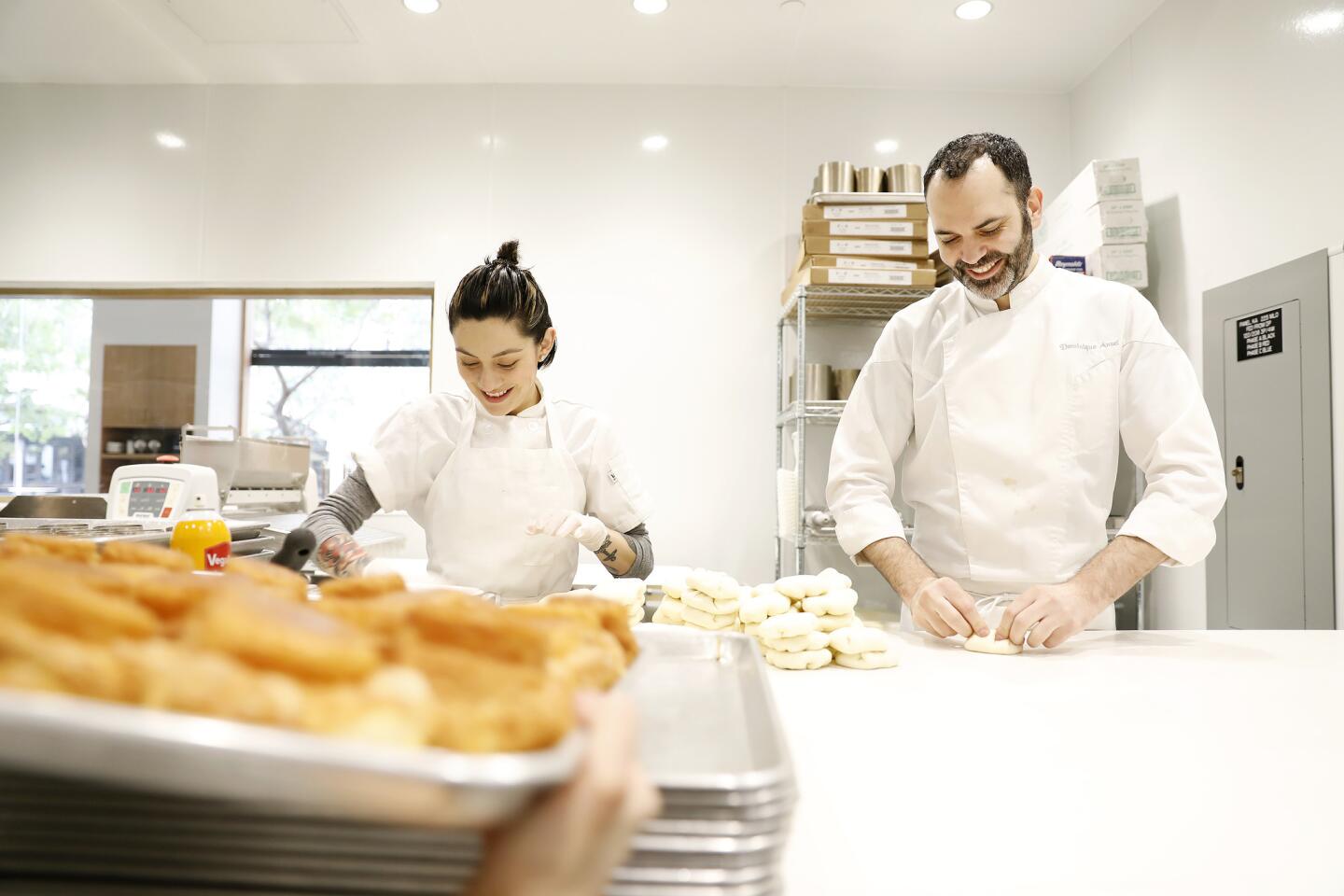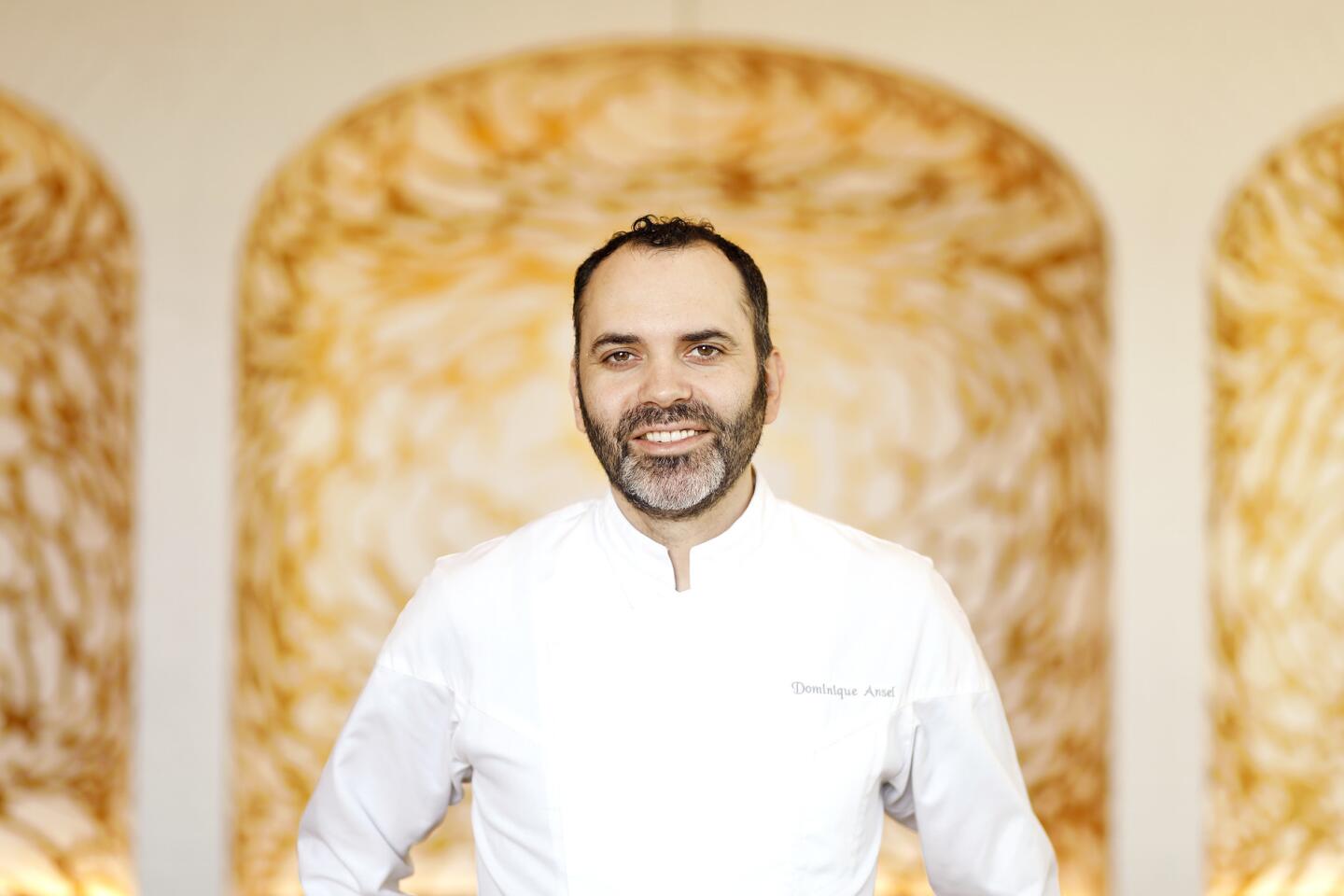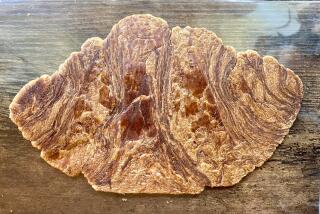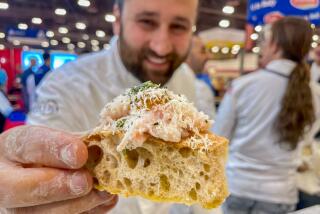How does that gingerbread pinecone get made? Take a look inside Dominique Ansel’s new L.A. bakery

Dominique Ansel Bakery at the Grove in Los Angeles.
“This is hard to make,” says chef Dominique Ansel of his kouign-amann, a deeply addictive Breton pastry made of caramelized laminated dough, as he lightly rubs a sheet of dough with sugar. “It’s like the omelet of pastry. The dough is going to absorb the sugar and it can easily turn into a syrup if you’re too slow and if it’s not cold enough.”
It’s almost 8 a.m. on a Saturday morning at Dominique Ansel Bakery and 189 by Dominique Ansel, the two-story complex at the Grove outdoor mall that is Ansel’s new Los Angeles outpost, and the kitchen is bustling in preparation for opening. Trays of Ansel’s Cronuts, his absurdly famous croissant-doughnut hybrids, are given a piping of pink fondant frosting before being carried out to the pastry case.
Upstairs, in a space adjacent to the large open kitchen, where a team of chefs prepares for brunch (this is the chef’s first full-service restaurant), the more intricate pastries receive finishing touches. The Gingerbread Pinecone, a spiced dessert made with speculoos ganache, ginger mousse and gingerbread cake, is constructed with more than 60 chocolate petals, each meticulously placed by hand before being dusted with a light snow of powdered sugar. And the Ruby Tart, an L.A. exclusive inspired by Dorothy’s ruby slippers in “The Wizard of Oz,” made with lychee mousse and cherry jam, is adorned with pomegranate seeds applied one by one, by hand.
The French-born pastry chef, 40, is stationed in front of the lamination machine making those kouign-amann, his most popular pastry, called the DKA. They’re a lighter version of the traditional cake with only five ingredients: flour, salt, butter, yeast and sugar. After folding an enormous sheet of dough around a large sheet of butter (imagine a giant dough envelope encasing a letter made of butter), he sends it back and forth through the conveyor belt of his lamination machine, deftly adding the sugar. It’s this folding and rolling through the machine that creates thin, buttery layers.
Next, quality control. “All right, shall we start with the croissant?” Ansel, in his white chef coat, holds up a pastry like a scientist.
“The true skill of a great pastry chef rests on a croissant,” he says, cutting it in half to expose the “honeycomb” layering inside, then inhaling the scent. “The smell is one of the most important things to me. It should smell like fermentation. It should be light. It shouldn’t be too sour. It shouldn’t be bitter. It shouldn’t be vinegary. It should be a nice, buttery fermentation.”

The Gingerbread Pinecone, a spiced dessert made with speculoos ganache, ginger mousse and gingerbread cake, is constructed with more than 60 chocolate petals, each meticulously placed by hand before being dusted with a light snow of powdered sugar.
At 8:45 a.m. Ansel and his partner, Amy Ma, hold a pre-shift meeting. The bakery’s front-of-house staff lines up, dressed in matching suspenders and bow ties, for a sampling of a raspberry tart special and a game of telephone, to help with communication skills. (Ma always starts the game, which goes something like this: “Five croissants, three California rolls, three DKA, two Cronuts and a latte.” If the staff gets it right everybody gets a cookie.)
Ma and Ansel, who are partners in both business and life, met 12 years ago at chef Daniel Boulud’s restaurant Daniel in New York City, when Ansel was pastry chef and she was a culinary school intern. In 2011 Ansel and Ma opened Dominique Ansel Bakery in New York with just four employees. Ansel describes working 20-hour days doing everything — washing dishes, taking out the trash, sweeping the floors. Ma pulls up photos on her phone of Ansel passed out on the floor of the bakery as proof. Three years later, he launched the Cronut, which became a pop-culture phenomenon. The pair now own and operate bakeries in London, Tokyo, New York (two), and this bakery and restaurant in Los Angeles, which opened in November.
As for the many offers Ansel has had to mass-produce his Cronut, he says he won’t. “I refuse because my dad worked in factories his entire life and he’s gotten nothing from it. I don’t want to be the one managing a factory,” Ansel says. “I want to be the one having the opportunity to keep on creating, to keep on pushing this industry forward and I don’t believe that selling out is the right thing to do. What do you leave behind you? Nothing. I believe in more than that; I believe in creativity.”
By 9 a.m. it’s time to open the doors. A crowd has been gathering for more than an hour, its enthusiasm — some ask Ansel for autographs like fans at a rock concert — commensurate with that of the chef, who has been up since 4 a.m. working in his bakery.
“Good morning!” Ansel greets the customers one by one, holding the door open, more like a modest shopkeeper than a guy who has more than 300,000 followers on Instagram and last year was named the World’s Best Pastry Chef. He hands out just-baked madeleines — he is very serious about them being warm — as a thank you for everyone’s patience. “They’re alive,” he says pointing to the small box of cookies. “When the chef puts it in front of you, you don’t wait to eat it. Time is everything. Time is a pure ingredient of every recipe.”
Ansel has put in a lot of time to get where he is today. “My first year in the kitchen was horrible,” he says of having to work in a kitchen at 16 to support his family in Beauvais, a poor suburb of Paris. “I was abused verbally, physically, like cutting me with knives just for fun, burning me with spatulas, hitting me. It was the old school way in France for you to learn.” Which explains why there is no swearing or yelling allowed in any of Ansel’s kitchens.
After serving in the military in French Guiana at 19, he returned to France and spent eight years at Fauchon, where he mastered French pastry techniques. By 24 he was managing more than 100 employees. In 2006 Ansel was invited to fly to New York and do a tasting for Boulud, one of the most highly regarded French chefs in the world. Ansel stayed at Daniel for seven years.
“I loved his ability to create very fine desserts, very focused flavor and texture with a restrained approach. I always enjoyed his creativity. He always had a mind of his own,” Boulud says now.
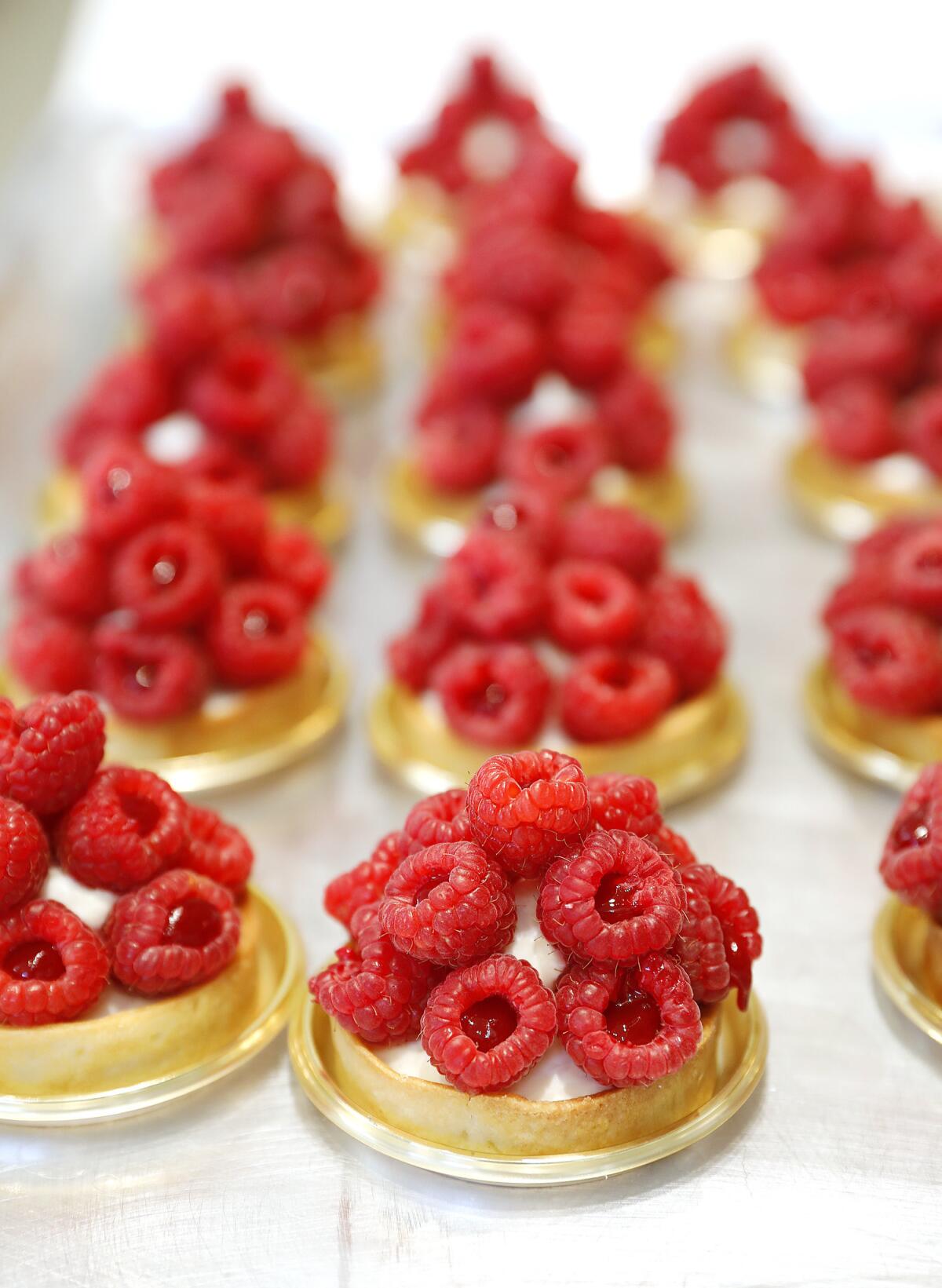
These days Ansel’s pastry cases are filled with outside-the-box, fantastical creations, among them a frozen s’more made with Tahitian vanilla ice cream covered in crisp chocolate feuilletine, wrapped in honey marshmallow and torched to order on a smoked willow wood branch. Los Angeles has inspired the California Roll, a cubic avocado and vanilla lime mousse with honey gelée and almond biscuits. Another L.A. invention? An avocado toast ice cream sandwich.
“Lately I’ve been looking into 3-D chocolate printing,” says Ansel, who’s equally fascinated by pottery wheel techniques, spiral art toys and Japanese 3-D Jell-O cakes.“PVC molds to cast. I’ve been looking at silicon; I’ve been looking at nail art.” He pulls out his iPhone and an Instagram account dedicated to nail art. “There’s a nail art technique to engrave a pattern. I think there’s something to do with pastry with that.”
By 11 a.m. Ansel watches as guests file in to eat brunch upstairs. “I love L.A.; I love the weather,” he says, smiling as he peers out the big windows of his restaurant at yet another sunny day. “I’ve been able to transform what I thought was a job into pure love.”
189 the Grove Drive, Los Angeles, (323) 601-1167, dominiqueansella.com.
More to Read
Eat your way across L.A.
Get our weekly Tasting Notes newsletter for reviews, news and more.
You may occasionally receive promotional content from the Los Angeles Times.
